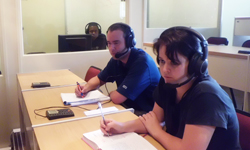Latest News Archive
Please select Category, Year, and then Month to display items
11 June 2021
|
Story Rulanzen Martin
|
Photo Courtesy of artists and the Johannes Stegmann Gallery.
![]()
Liminality is an exhibition of first-, second- and third-year student’s work in the
Department of Fine Arts at the University of the Free State (UFS). The works are from 2019 and 2020. Created during the hard lockdown of 2020, the artworks provide a glimpse of what students had to deal with and overcome during these times.
In a proposal for the exhibition, Angela de Jesus, Curator of the UFS Art Galleries, wrote: “The subtitle of the exhibition is ‘threshold, transition, transformation’ and it refers to the creative processes that students engaged with
in these adverse circumstances resulting in a wide array of artworks in both traditional and adapted mediums.”
The exhibition speaks to our shared experiences of insecurity, fragility, and discord, and to the resourcefulness and immutability of creative expression.
The virtual exhibition runs until 2 July 2021.
The exhibition is also currently available for viewing at the Johannes Stegmann Art Gallery, Sasol Library, UFS Bloemfontein Campus. Monday - Friday 09:00 - 16:00.
 MEGAN JOHNS, Battleground, Tobacco, charcoal dust, plaster of paris and resin, 93.5 x 50 x 7.5 cm
MEGAN JOHNS, Battleground, Tobacco, charcoal dust, plaster of paris and resin, 93.5 x 50 x 7.5 cm
 JACOBETH SELINGA, Linda, Installation: Found bed, wool and thread, 257 x 196 x 91 cm
JACOBETH SELINGA, Linda, Installation: Found bed, wool and thread, 257 x 196 x 91 cm
 POLOKO MOHANOE, Prayer for rain, Gouache on Fabriano, 66 x 72.8 cm
POLOKO MOHANOE, Prayer for rain, Gouache on Fabriano, 66 x 72.8 cm
 SEBOTSE SELAMULELA, In my image (Coronavirus head), Clay, 35 x 40 x 60 cm
SEBOTSE SELAMULELA, In my image (Coronavirus head), Clay, 35 x 40 x 60 cm
 WILLIAM SHAER, Creator, Deconstructed chair, koat wood and Imbura wood, 100 x 75 x 45 cm
WILLIAM SHAER, Creator, Deconstructed chair, koat wood and Imbura wood, 100 x 75 x 45 cm
 Johannes Stegmann Gallery
Johannes Stegmann Gallery
 Interior of the Johannes Stegmann Gallery
Interior of the Johannes Stegmann Gallery
“To interpret is more than the ability to have mastered two languages”
2014-03-27
|
 |
It is equally unfair to the accused as the victim when an untrained court interpreter is used in a court case.
In South Africa there are currently a large percentage of interpreters employed by the Department of Justice without any formal training.
While interpreting is in reality a very complex subject, the general acceptance is that everybody who is able speak two languages or more can be an interpreter.
This perception harms interpreting as a profession, as it results in most institutions appointing any multilingual person as an interpreter.
In many cases people are used to interpret into and from their third or fourth language (of which Afrikaans is one). This leads to inaccuracy and the incorrect use of expressions and terminology. Specific cognitive processes also have to be developed and practiced.
The University of the Free State (UFS) has since 2008 trained approximately 200 court interpreters in South Africa. This training includes the theory of interpreting and practical exercises, as well as the development of terminology and a basic knowledge of the legal system in South Africa.
The training provided to court interpreters by the Unit for Language Management and Facilitation, is done in conjunction with the Department of Justice and Constitutional Development and SASSETA (Safety and Security).
Apart from Afrikaans, native speakers of all South African languages are included in the training.
Much attention (rightfully) are given to interpreters who can interpret between the nine African languages and (mostly) English, but in the process the development of interpreters between Afrikaans and English was neglected, as became apparent in the past two weeks during the Oscar Pistorius case.